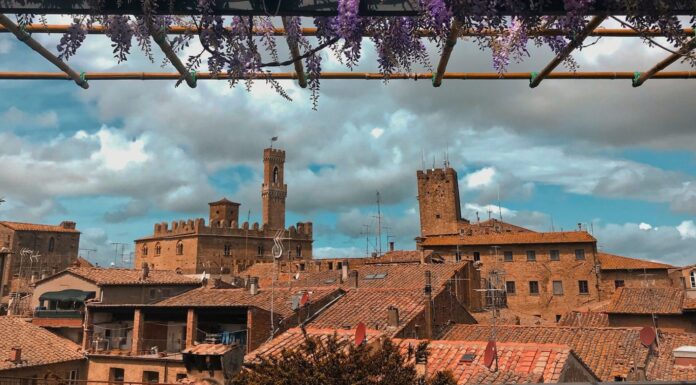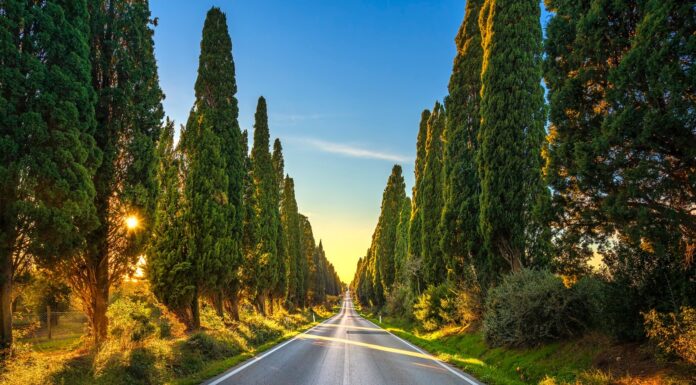What is Rome famous for? The so-called “City of Seven Hills” (from the Italian “La città dei 7 Colli”) surely stands out for multiple things, from being chosen as the seat of the Roman Empire to its stunning architecture and its naturalistic heritage, making the metropolitan city worth a visit. Rome, indeed, is absolutely a must-see destination for those who are looking for an alternative way to learn more about Italian culture, lifestyle and history.
Built in 753 BC, Rome allows you to understand better how Italy has historically become a melting pot of traditions and empires. From the Augustan Age to the Contemporary Age, you will be able to admire the open-air museum of Villa Borghese, fall in love by hearing legends of Apollo and Daphne statues and discover the beauty of the Renaissance by stopping at Michelangelo’s Sistine Chapel. Definitely an experience you can’t miss.
Keep on reading the article to find out everything about what is Rome famous for, what to see and eat once there.
Things that Make Rome Famous in the World
Adjacent to Vatican City, Roma Caput Mundi is globally known for numerous factors, from its history remains to the gastronomical relevancy. Let’s find out the main reasons.
Roman Empire
Here’s a list of what you must see upon your arrival in the Eternal City to fully understand what the Roman Empire left as testament to a powerful and enduring legacy.
1. Colosseum
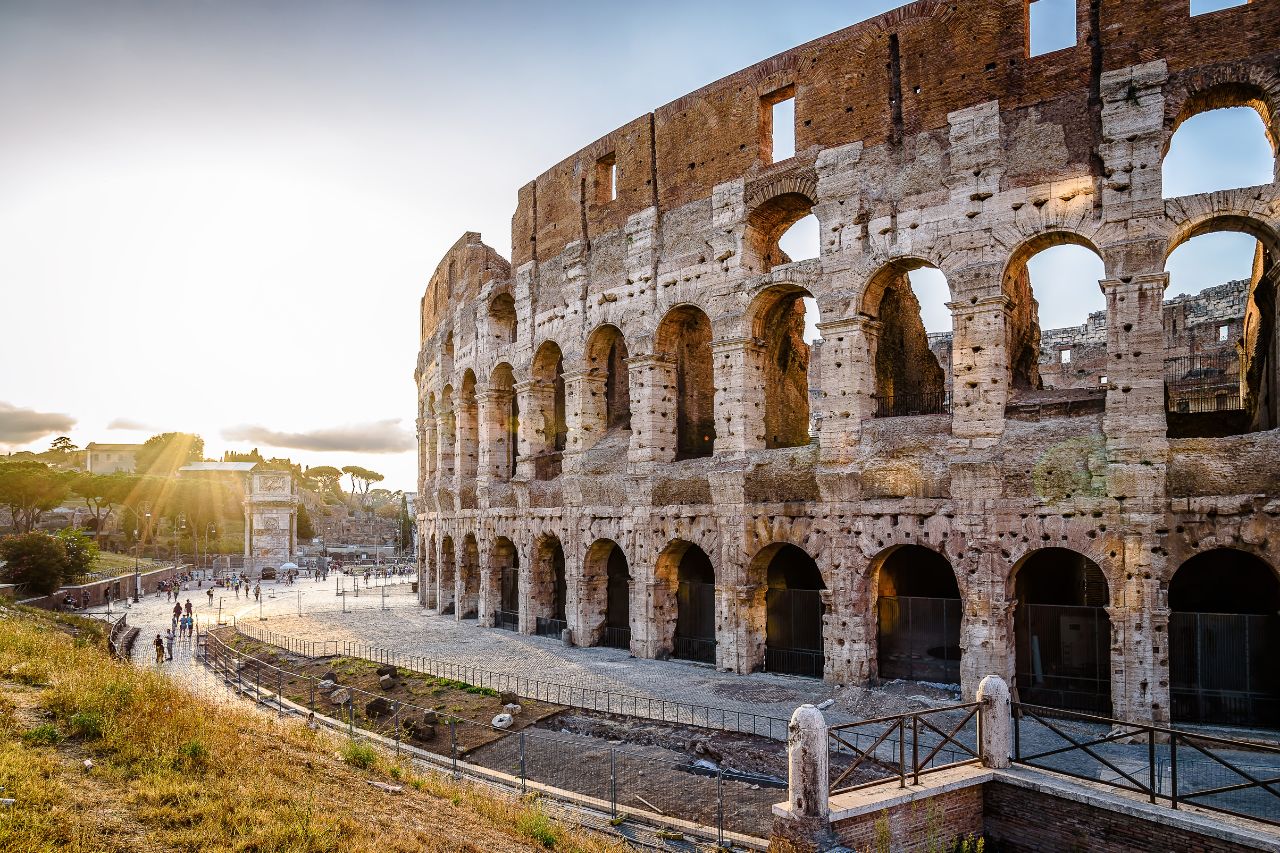
The Colosseum (alternatively named “Flavian Amphitheater”) is definitely what Rome is famous for. Elliptically shaped, this complex was built in 72 AC under the Emperor Vespasian’s will and completed in 80 AC by his son, Titus. This monument was used as an arena to host multiple events, from Olympic games and gladiator fights to executions of prisoners and a fortress of building materials thanks to its capacity of approximately 70.000 seats.
Today, the Colosseum stands as a powerful symbol of ancient Rome’s architectural brilliance and cultural might. It draws millions of visitors who come to marvel at its enduring beauty and to imagine the spectacles it once hosted, echoing through history.
2. Roman Forum
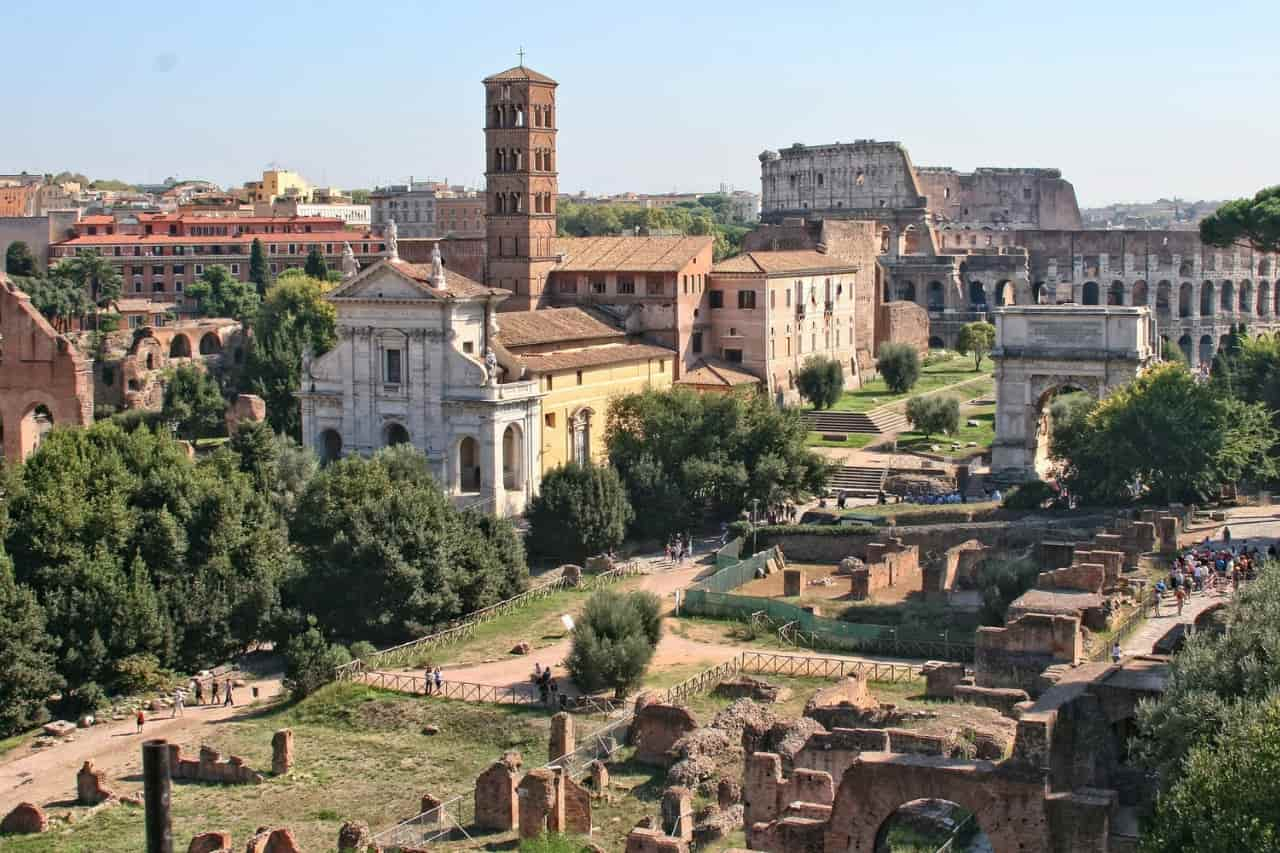
Not too far from the Colosseum, the Roman Forum is definitely a renowned naturalistic and archeological site. The latter, indeed, was once considered as the fulcrum of social and commercial life of ancient Rome and gained its actual look thanks to a remediation. As a new visitor, we strongly recommend you visit the Curia Julia (3rd senate house of the Roman Empire), the Rostra and the Column of Phocas.
Intriguingly, wandering through the remnants of the Forum transports you back in time, allowing you to envision the vibrant marketplace and political gatherings that shaped the city’s history. Don’t miss the chance to absorb the rich historical tapestry woven into every stone, as each step echoes the footsteps of ancient Romans, unraveling tales of triumph and legacy that continue to captivate curious minds today.
3. Pantheon
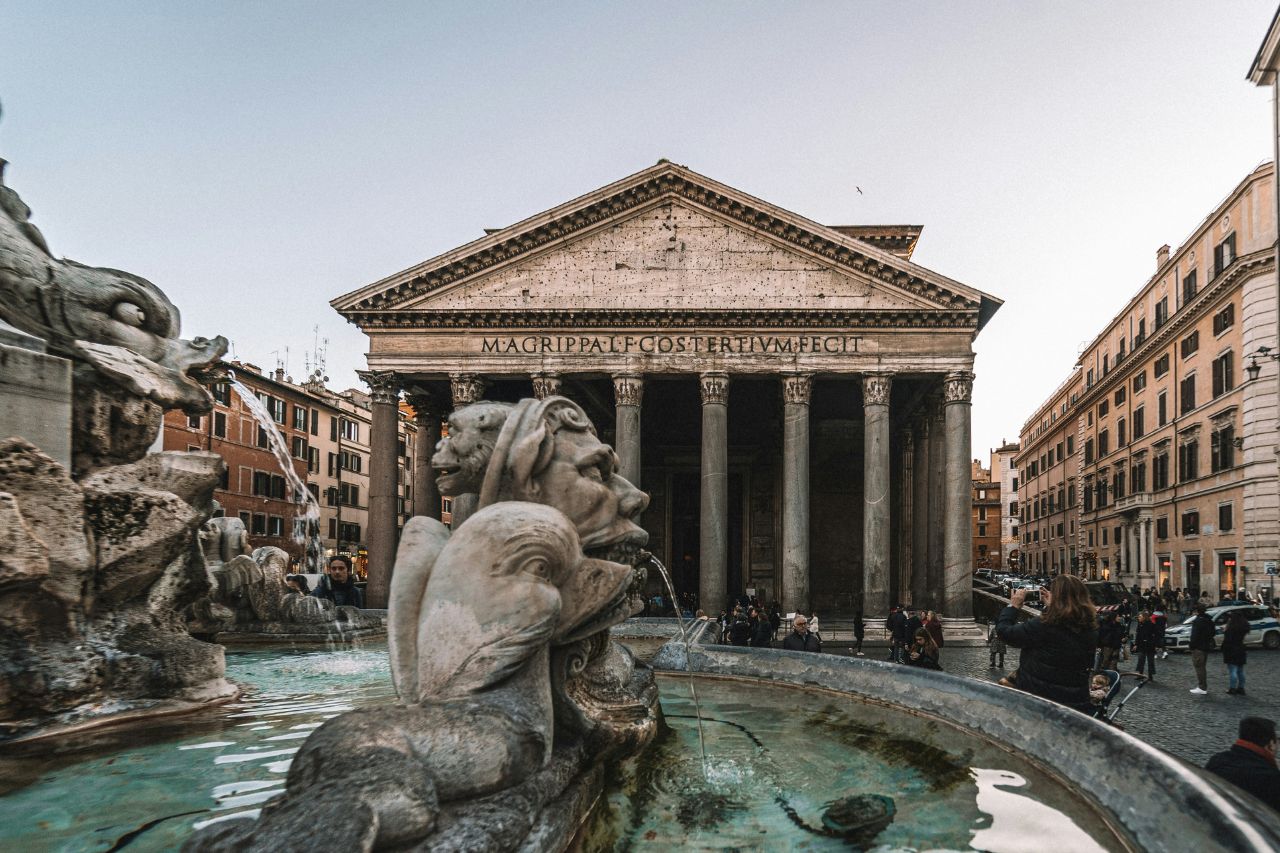
Set near Navona Square, the Pantheon is a monument built around 25 BC. Known for being one of the most visited complexes, it was used as a place of worship for the gods and then converted into a Catholic church in the 7th century. Once there, take your time to be overwhelmed by the beauty of its external architecture and the timeless dome, characterized by the presence of an oculus.
This was pretty useful to light up the building, accentuate its grandeur and allow scientists to study the stars and their secrets. Exploring the Pantheon entails immersing oneself in a millennia-spanning history, contemplating the admirable fusion of classical design and innovative construction techniques.
4. Circus Maximum
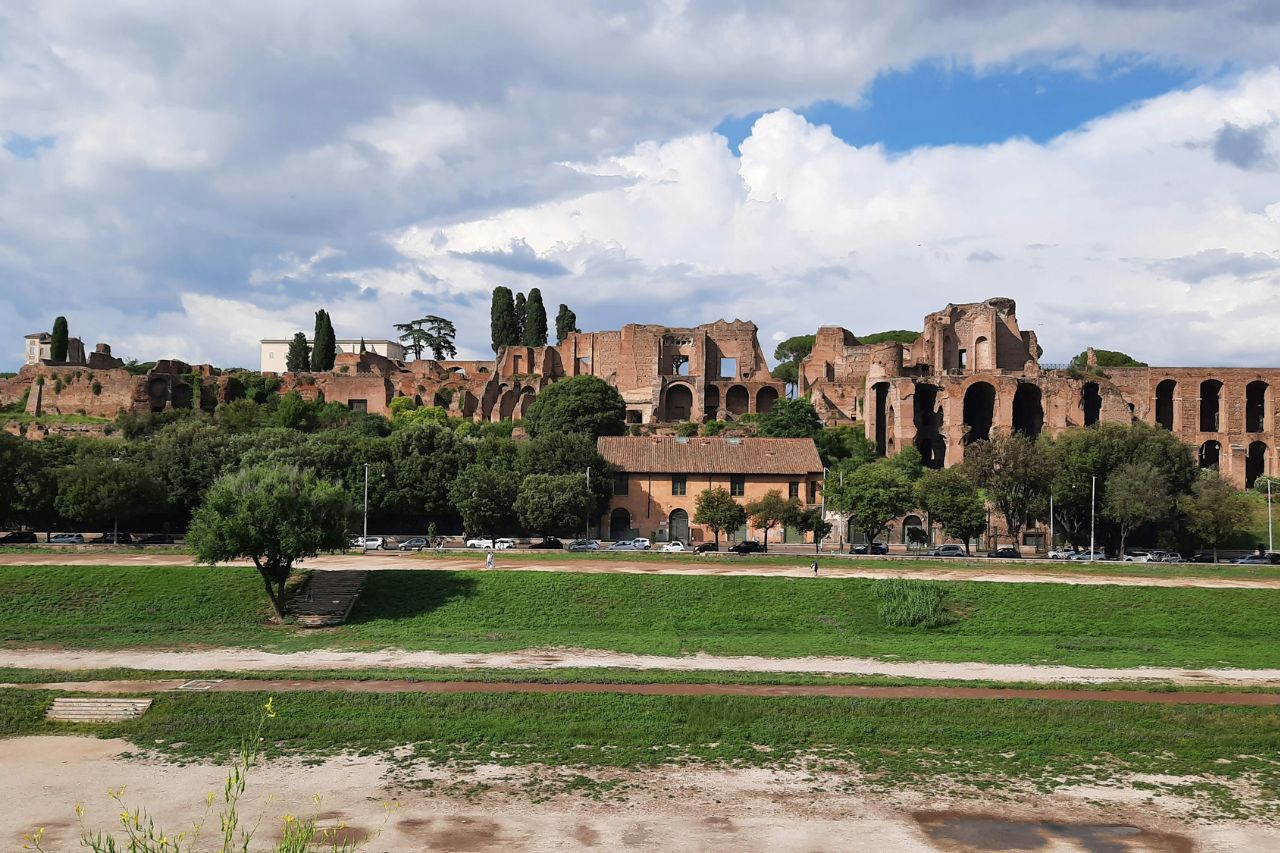
Known as the heart of concerts by Roman people, the Circus Maximus was built in 46 BC under Julio Caesar’s wishes. This site was anciently used as an arena to celebrate Roman religious festivals and to watch horse racings thanks to the muddy soil. Upon your arrival, enjoy this open-air museum by booking a Circus Maximus Experience and by stopping at the Arch of Titus, the Palatine hill and the Triumphalis door.
As you explore, imagine the chariots racing, the cheers of thousands, and the grandeur of ancient Rome coming alive around you. This journey back in time is a captivating experience, blending the echoes of historical grandiosity with the serene beauty of present-day Rome.
5. Catacombs

Do you know what else Rome is famous for? The Catacombs. These (from the Italian ‘Catacombe’) are an underground complex built up to the 5th century as a cemetery for Roman Christians or Jews who didn’t want to bury their relatives. During the persecution of Catholics, the latter took refuge here to pray. Despite this, during the barbarian invasions this site was the victim of many thefts and looting.
When in Rome, then, you can’t miss the Catacombs of San Sebastiano, of Priscilla, of San Callisto. Step into these hallowed tunnels and feel the solemnity and mystery that shrouds these ancient burial grounds. Here, the silence speaks volumes, echoing the stories of faith and resilience, offering a unique and profound glimpse into Rome’s multifaceted history.
Art and Culture
Let’s take a look at the most relevant masterpieces and their histories lying in the Italian capital.
6. Michelangelo’s Sistine Chapel
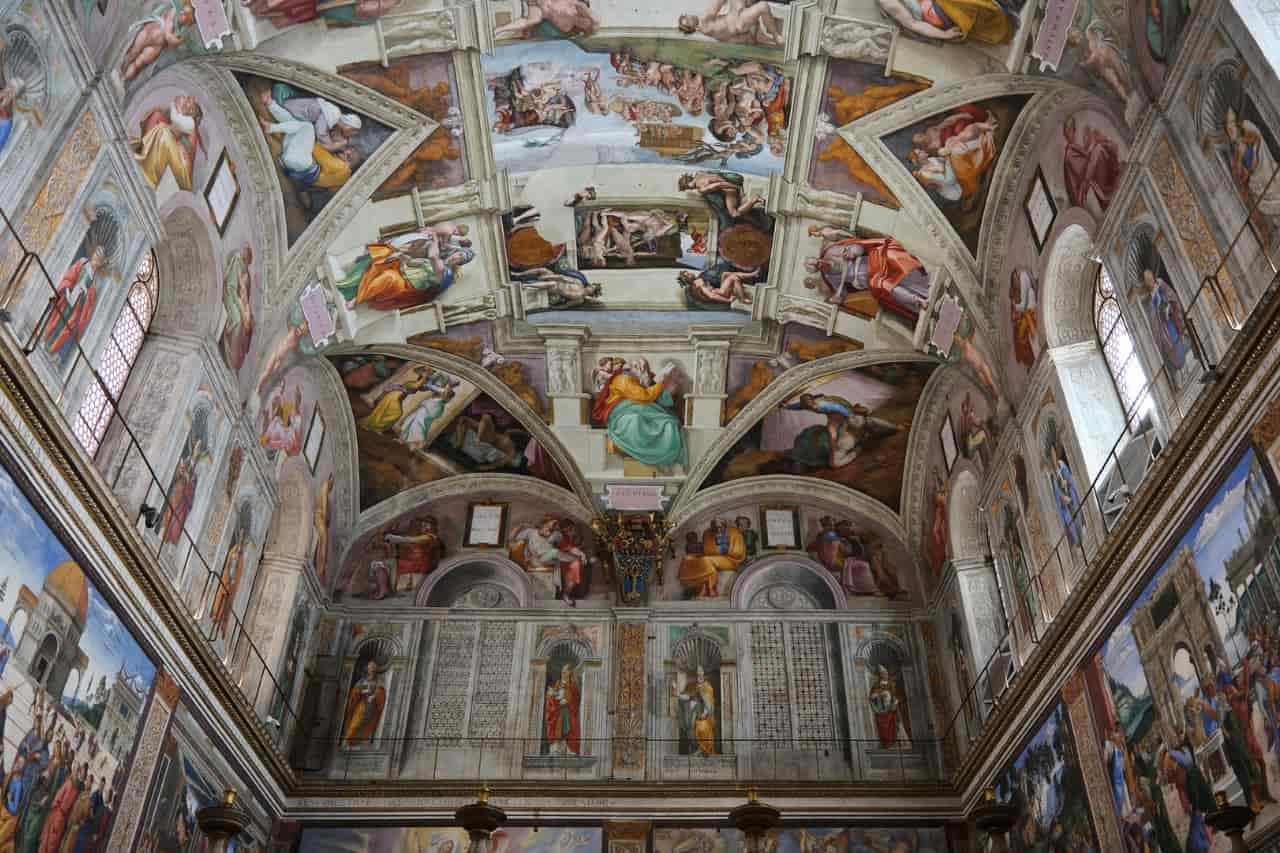
The 800 square meters the Sistine Chapel is a suggestive area built in the 15th century and frescoed by Botticelli and Pinturicchio. However, Michelangelo contributed to its embellishment in 1512 when he painted: the “Last Judgment” (depicting God, his Kingdom, the Virgin Mary and the angels), the “Great Genesis” and the “Creation of Eva”, creating a symphony of art that beckons visitors to delve into the divine stories etched on the chapel’s walls, transcending the boundaries of time and space.
As you gaze upwards, the vibrant colors and expressive figures seem to come alive, narrating biblical tales with an intensity that is almost palpable. Michelangelo’s masterful use of perspective and anatomy not only showcases his artistic genius but also offers a window into the spiritual and cultural ethos of the Renaissance era.
7. Raphael’s Masterpieces

Raphael spent most of his life working in Roma. Indeed, when in the capital, you can’t forget to admire “la Fornarina” (in Palazzo Barberini), the “Room of the Signatura” (located in the Vatican Museums) and its frescoes for Villa Farnesina. Considering its meticulous work, the artist is now buried at the Pantheon next to other valid characters. Each of his creations is a testament to his genius, blending harmonious compositions with rich, emotive expressions.
The subtlety in the play of light and shadow in his work brings each scene to life, inviting you into a world of Renaissance beauty. As you stand before these masterpieces, it’s not just the art you witness, but the passion and soul of Raphael himself, forever immortalized in these timeless pieces.
8. Trevi Fountain

Symbole par excellence of the Dolce Vita, the Trevi Fountain is one of the reasons for what Rome is famous for. The 26 meters tall masterpiece counts 3 frontal statues of the gods Abundance, Healthiness and Oceano. What catches the attention is also a scene of a girl telling Roman soldiers where to quench their thirst. As water cascades melodiously in the background, this iconic fountain invites you to partake in the longstanding tradition of tossing a coin over your shoulder, promising a return to the Eternal City.
The intricate details of the sculptures, combined with the grandeur of the design, create a magical atmosphere that is both awe-inspiring and deeply romantic. Standing here, amidst the splendor of this Baroque artistry, you’re not just a spectator but a part of Rome’s living, breathing history.
9. Altar of the Fatherland
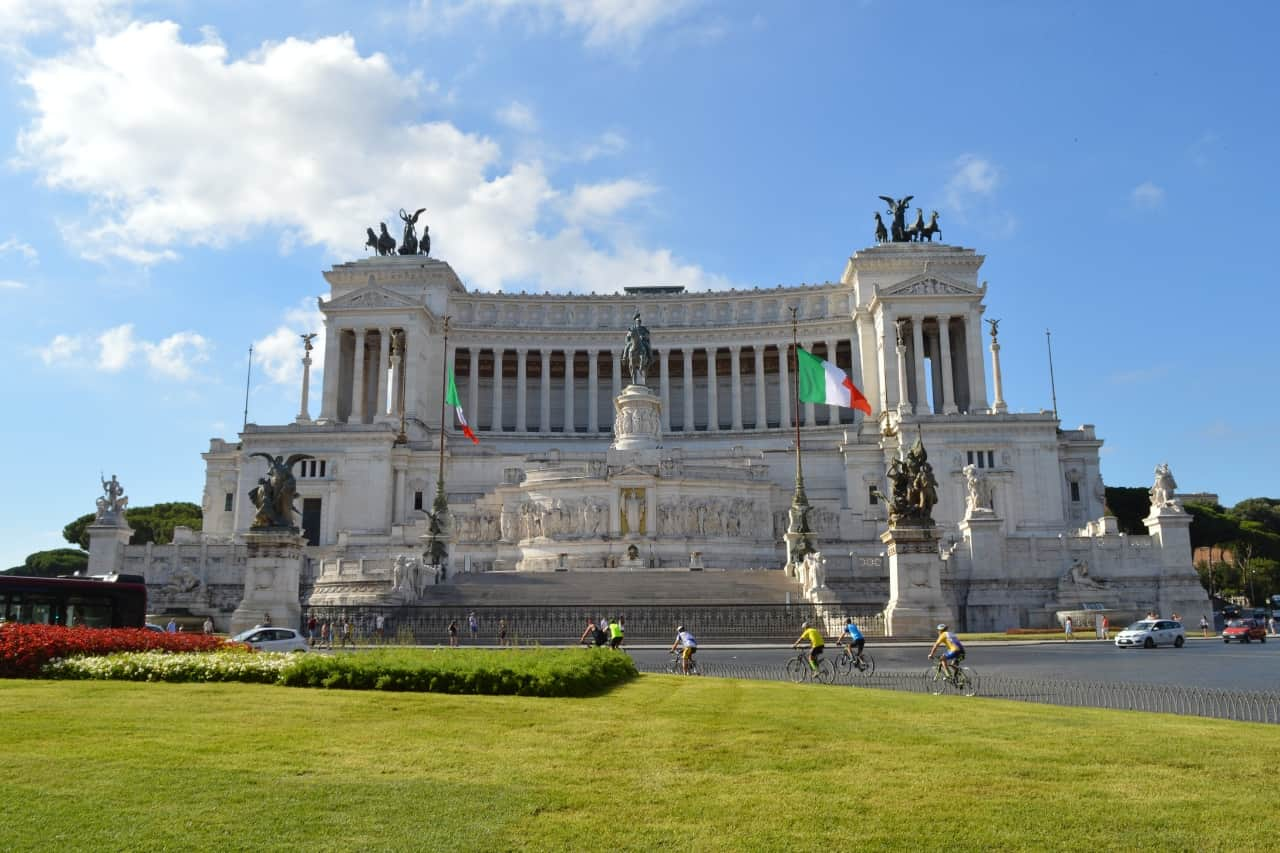
Mostly made of Brescia stone, the Altar of the Fatherland is the main character of Piazza Venezia. Built in 1906, this part of the complex is the place where the Tomb of the Unknown Soldier lies since the 20s. The latter is a monument dedicated to young men who left Italy and died at the war fronts. What stands out the most is the architecture, rich in inscriptions homaging the patriotism and the courage of these militaries. The grandeur of the monument is not just in its physical presence but also in the profound symbolism it carries.
As you walk around, the impressive statues, intricate friezes, and majestic stairways narrate stories of national pride and sacrifice. This landmark serves not only as a remembrance of Italy’s past but also as a beacon of unity and resilience.
10. Castel Sant’Angelo
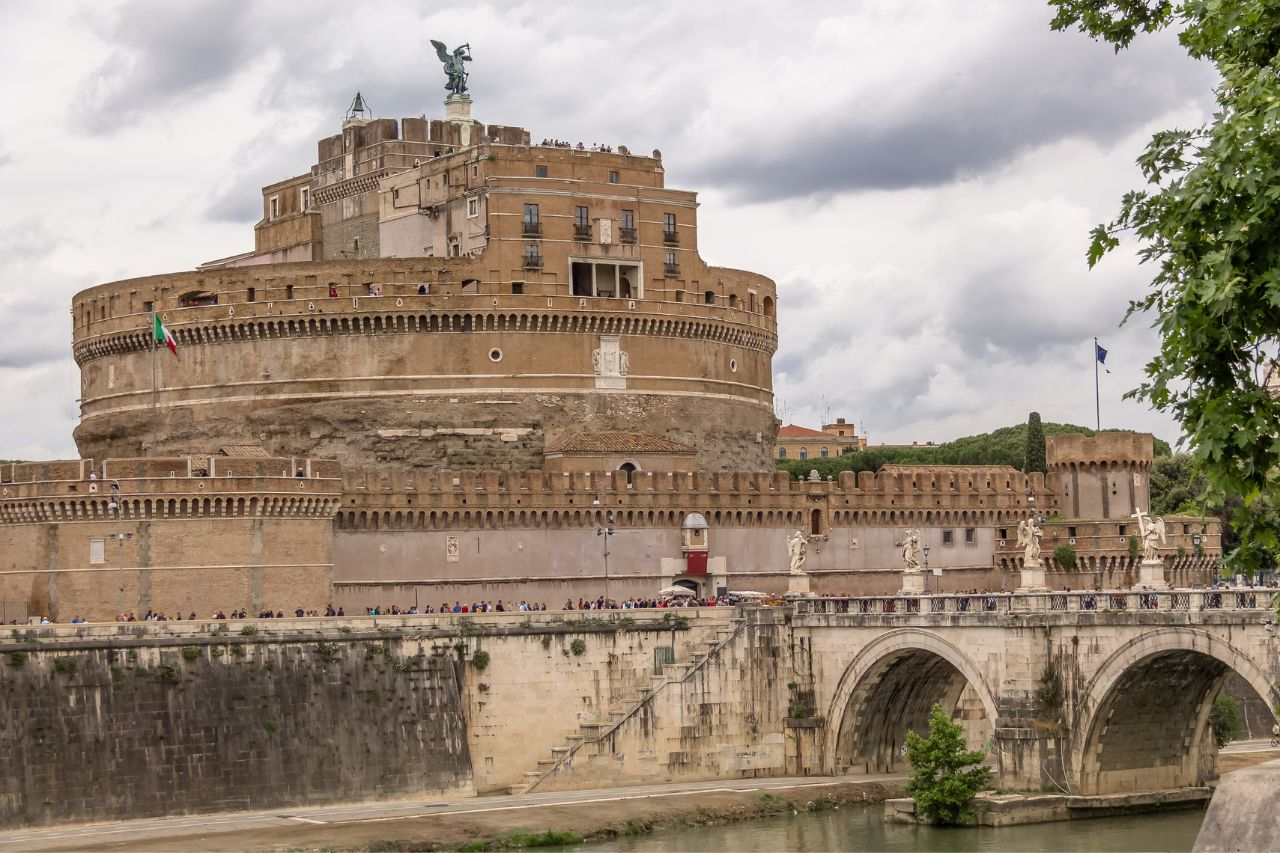
Set in the heart of Lungotevere, Castel Sant’Angelo is definitely a must-see gem built in 35 AC under Hadrian’s wishes. The structure changed its function multiple times, from military shelter to Papal residence (in the Renaissance) and prison. On the top stands out a huge bronze statue depicting S. Michael the Archangel. On the inside, you need to admire the Treasury Room, the library (especially as a book buff) and the Cagliostra (net of cells). The entrance ticket costs 24$ circa.
As you explore this historical fortress, each corridor and room unveils a layer of Rome’s tumultuous past. The panoramic views from the top are breathtaking, offering a unique perspective over the Tiber and the city. The Castel Sant’Angelo is not just a monument, but a chronicle of Rome’s legacy, a place where art, history, and legends intertwine to tell the story of a city eternally steeped in glory and intrigue.
Temples
With its strong connection with mythology, here’s everything you need to know about Rome and its temples.
11. Hercules Victor

Do you know which temple Rome is famous for? Set in Bocca della Verità Square, the Hercules Victor (also known as Ercole Invitto) is a temple dating back to the 2nd century BC. The complex, totally made of marble, was designed by Hermodoros di Salamina (Greek architect) and dedicated to the homonym protector of merchants. From the outside, it’s impossible not to be amazed by the twenty Corinthian columns placed on a completely made of tuff stone. This architectural masterpiece stands as a testament to the blend of Greek and Roman artistic influence.
As you circle the temple, the play of light and shadow across the columns creates a mesmerizing effect, transporting you back to ancient times. This site is not just an attraction but a silent witness to centuries of history, trade, and cultural exchange.
12. Saturn
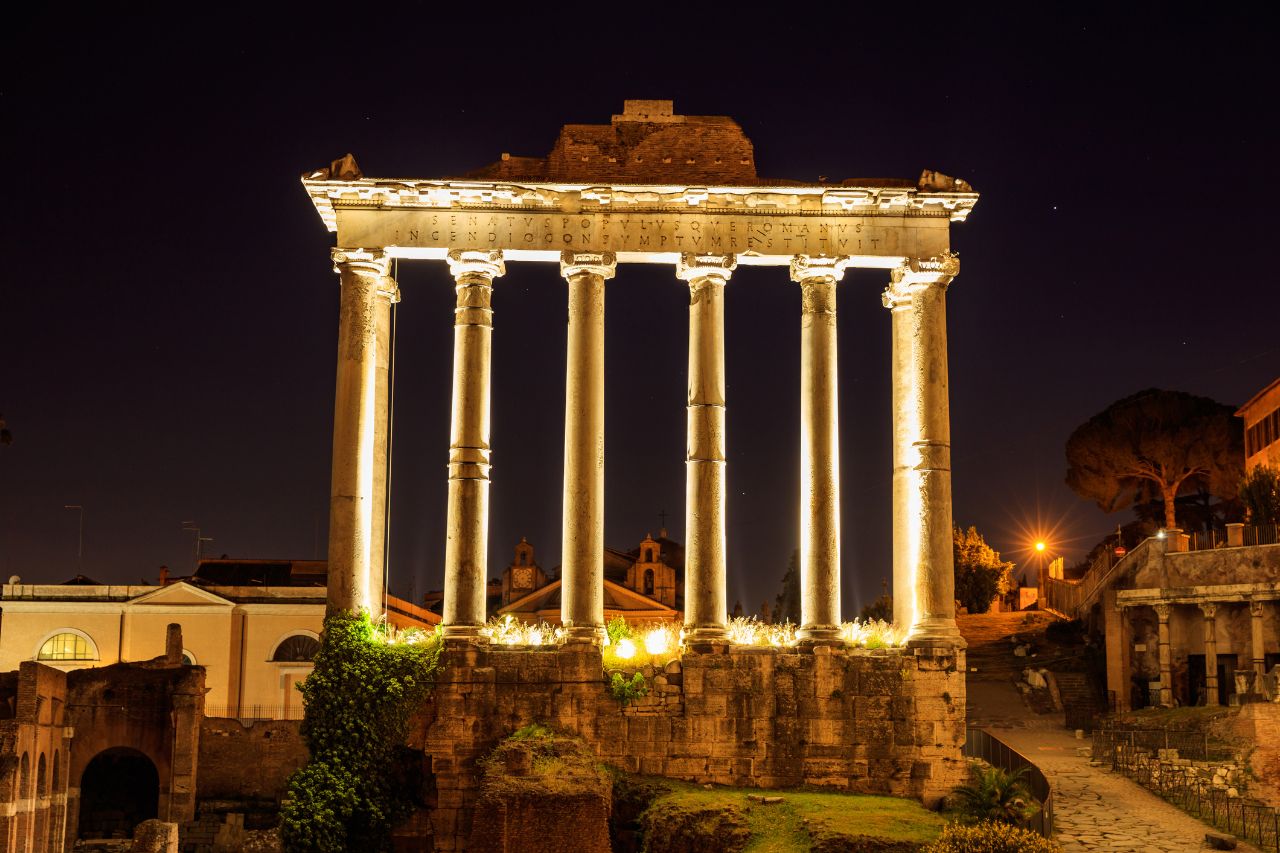
Located in the center of the Roman forum, the ancient temple of Saturn was built in 497 BC. The site is dedicated to Saturn, a mythological god who (according to legends) taught the art of agriculture to Rome and its people. On an architectural level, the remains of the complex rest on a travertine base with the presence of 8 Ionic columns in Egyptian granite. The architrave, at the top of the masterpiece, has a rich frieze of acanthus leaves and palmettes.
Standing amidst these ruins, you’re enveloped in an aura of ancient mystique. The temple, though in ruins, still exudes a sense of grandeur and historical significance. It’s a place where you can contemplate the advancements and beliefs of early Roman society.
13. Venus and Rome
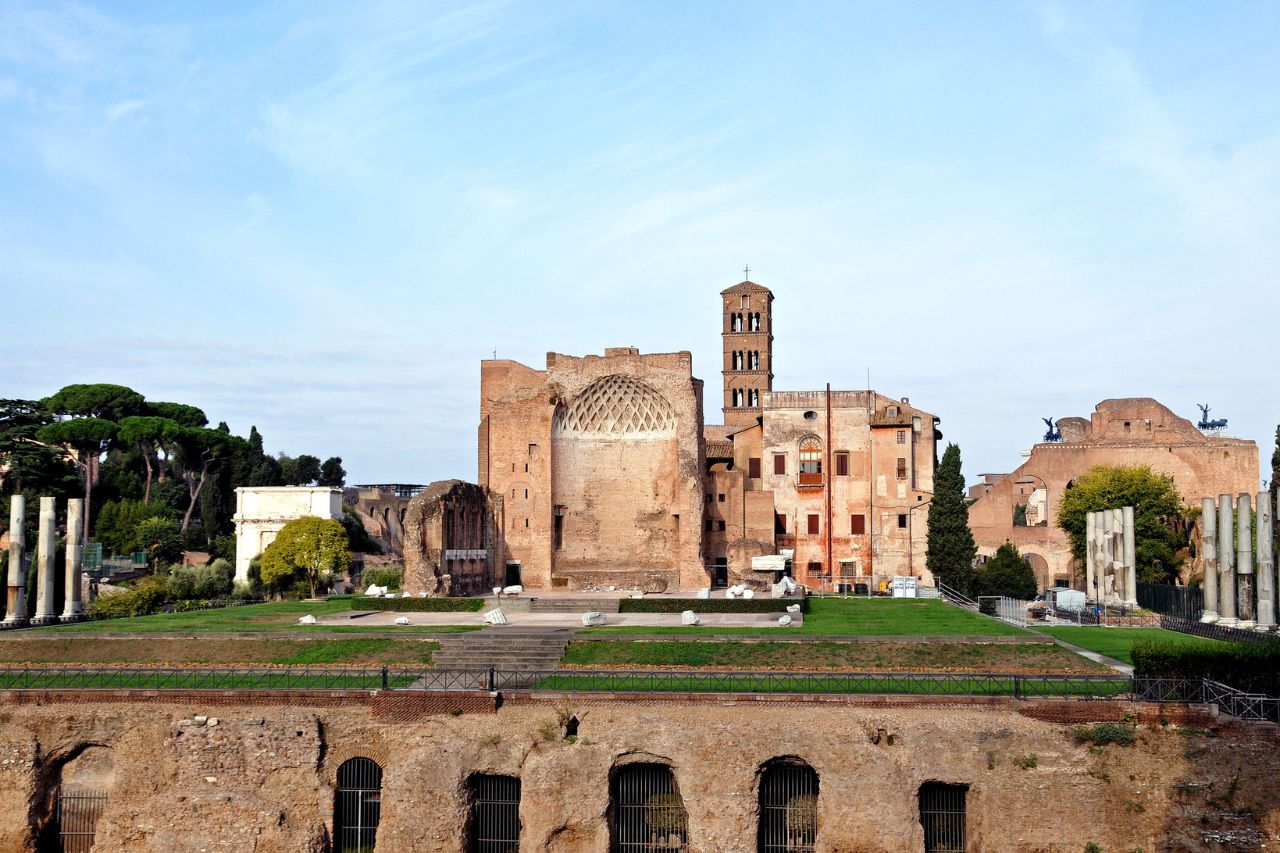
Based in the East side of the Roman Forum, the suggestive temple of Venus and Rome is a complex built under the Emperor Hadrian’s will. Inaugurated in 141 AC by Antoninus Pius, the site (rich in Greek details) was dedicated to the gods Venus Felix and Roma Aeterna. Furthermore, it was the protagonist of numerous restorations due to a fire which currently left a cell dedicated to the goddess Roma intact and preserved elsewhere (which became part of the San Francesca Romana church). As you explore this architectural marvel, you’re enveloped in the dual dedication to love and eternal city, symbolized by Venus and Rome.
The temple’s elegant design and grand scale reflect its importance in Roman religion and culture. Walking through this historic site, one can’t help but marvel at the fusion of art, history, and mythology, which brings the tales of ancient deities to life.
Statues
Here’s a list of all the most impressive statues you surely can’t miss.
14. David
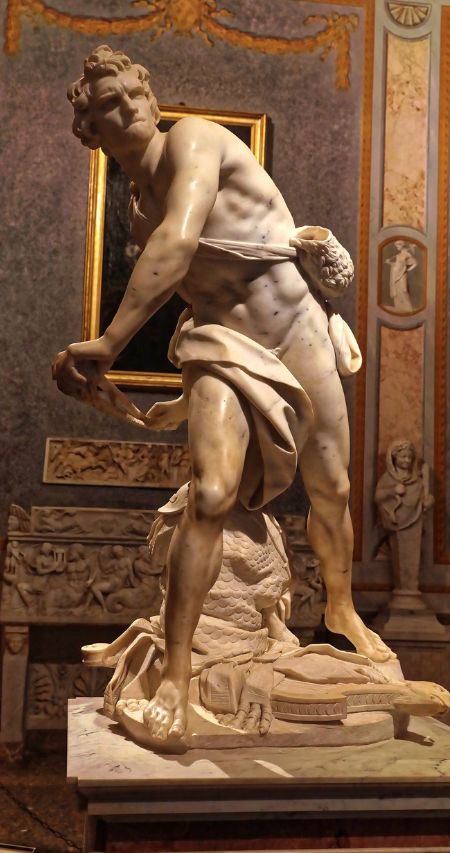
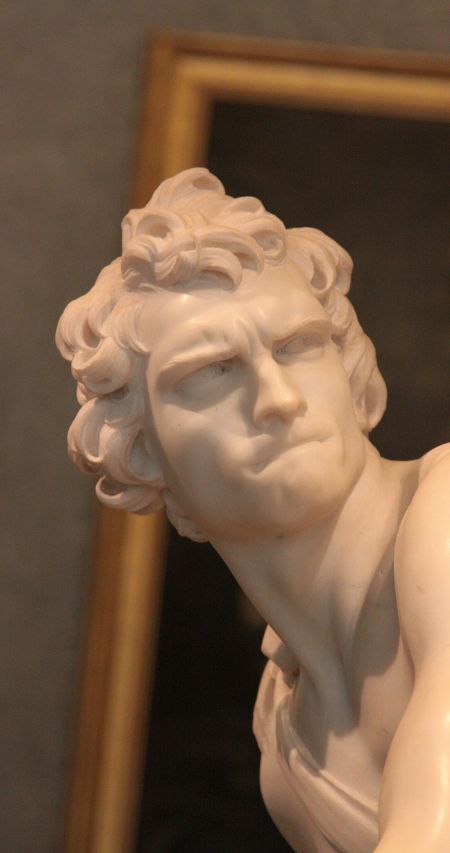
Have you ever seen the statue for what is Rome famous for? Set in the Borghese Gallery, the David is a sculpture made by G. Bernini in 1624 circa and commissioned by the cardinal Scipione Borghese. The work of art represents a young David – whose face is a self-portrait of the artist – throwing a stone at Goliath, a Philistine soldier. Not too far from the marble hero lies a zither, decorated with an eagle and a dragon, heraldic animals of the Borghese family. This masterpiece is a stunning representation of Bernini’s genius in capturing motion and emotion in marble.
The intensity and concentration in David’s expression, coupled with the dynamic twist of his body, offer a vivid portrayal of the biblical scene. The attention to detail, from the tension in David’s muscles to the intricate carvings on the zither, makes this sculpture a breathtaking sight.
15. La Pietà
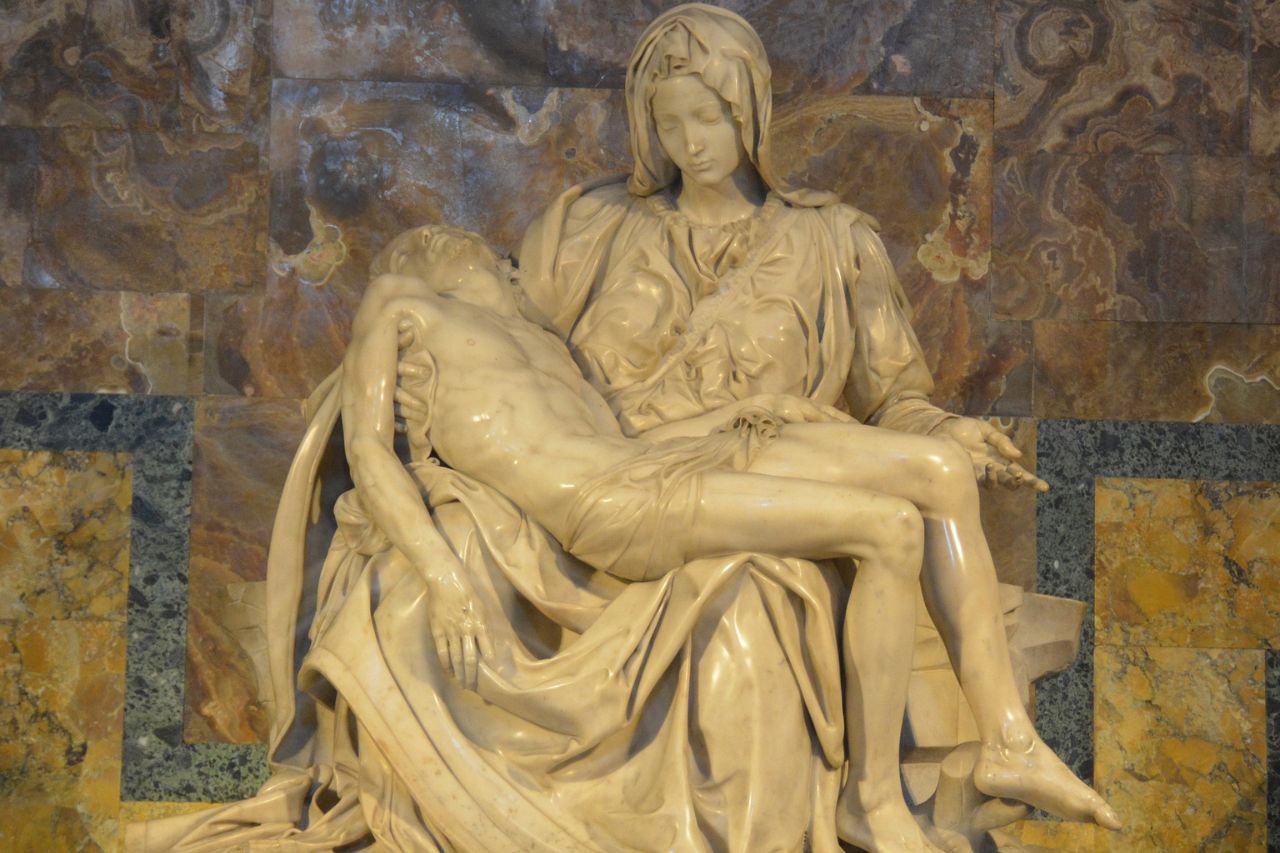
Based in St. Peter’s Basilica, the Pietà is a sculpture made by Michelangelo in 1499. The 1.74 meters high monument represents the Virgin Mary holding up his son, Jesus, after being deposed from the cross. The artist wanted to represent the symbols of death and life, in symbiose with each other and ready to reach divine perfection. Michelangelo’s mastery is evident in the exquisite detailing of the figures, from the folds of Mary’s robe to the peaceful expression on Jesus’ face. The sculpture emanates a profound sense of sorrow yet tranquility, capturing the essence of sacrifice and unconditional love.
It’s a moving piece that not only showcases Michelangelo’s unparalleled skill in carving but also communicates deep spiritual messages. As you stand before La Pietà, the emotional impact of this artistic marvel is palpable, making it an unforgettable highlight of any visit to St. Peter’s Basilica.
16. Apollo and Daphne

Located in the heart of the Borghese Gallery, the Apollo and Daphne statue was made by Bernini in 1625. The work draws inspiration from the manuscript “The Metamorphoses” by Ovid and depicts the moment when the god is reunited with the beloved nymph whose transformation is about to begin and who lifts her hands to her hair in desperation. The sculptor uses marble to create a contrast between light and dark. This dynamic sculpture captures the dramatic and emotional intensity of the mythological story.
Bernini’s genius lies in his ability to bring the figures to life, with Apollo’s determined pursuit and Daphne’s fearful flight frozen in an eternal moment. The exquisite detailing of Daphne’s transformation, with leaves and branches emerging from her body, showcases Bernini’s mastery over marble, blurring the lines between reality and the supernatural.
Gardens
Smell the perfume of the Eternal city by visiting these gardens.
17. Villa Borghese
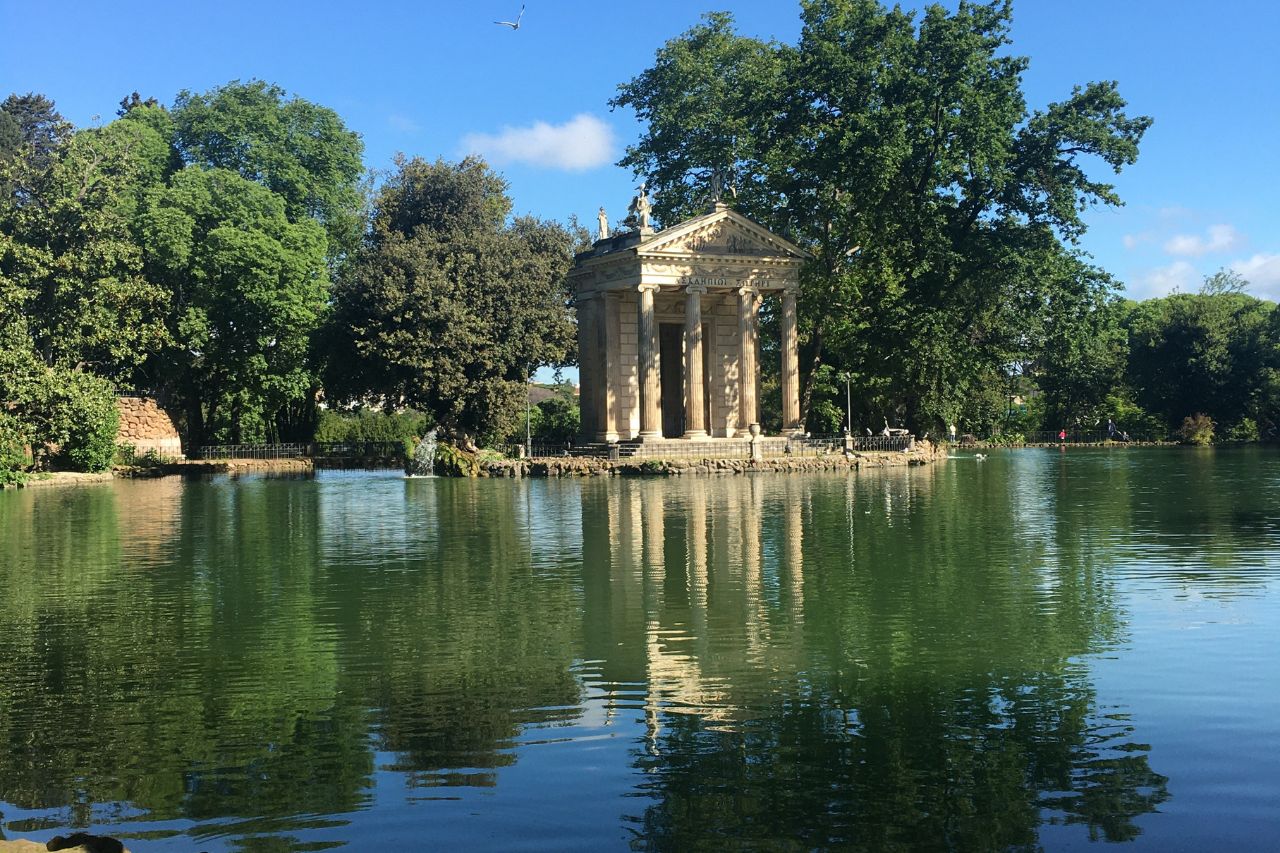
Villa Pinciana, also known as Villa Borghese, is a public park built in 1606 under the cardinal Scipione Borghese’s will. The green complex is much beloved for its proximity to the Pincio hill, the Goethe, Virgil and Dante statue and an artificial lake where you can rent a rowboat (for just 3$ per 30 minutes). At your arrival, we suggest you visit the Zoological Garden of Rome (or BioParco), which hosts many species of amphibians, birds and mammals from the whole world.
This lush oasis in the heart of Rome offers a perfect blend of nature and culture. As you stroll through the meandering pathways, enjoy the serene beauty of the gardens, the elegance of the statues, and the tranquil waters of the lake. The BioParco adds another dimension to your visit, offering an opportunity to learn about and appreciate wildlife from around the globe in a thoughtfully designed and maintained environment.
18. Botanical Garden
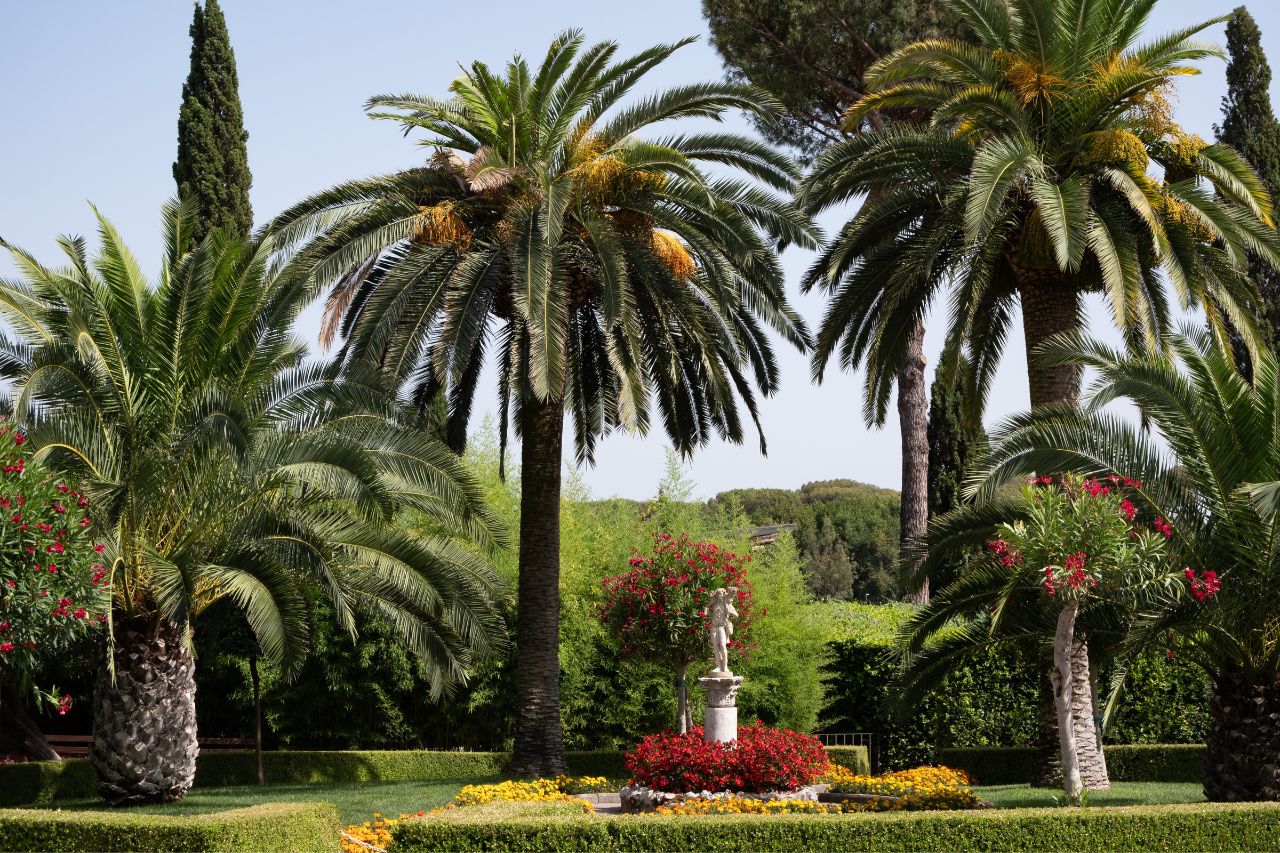
Have you ever visited the natural park for what is Rome famous for? Located in the heart of Villa Corsini, the Botanical Garden of Rome is a naturalistic site extending more than 13 hectares. Here, you can admire a rich collection of century-old trees, different types of bamboo, a Mediterranean Forest and a variety of Gymnosperms. However, at your arrival, you must stop at the Japanese Garden, the Rose Garden (at the height of splendor with the bloom of May) and the Serra Corsini (equipped with more than 400 orchid species). This botanical paradise offers a tranquil escape from the bustling city streets, inviting you to immerse yourself in the beauty of diverse flora.
Each section of the garden presents a unique ecosystem, showcasing the delicate balance of nature. The Japanese Garden, with its serene landscape and traditional design, provides a peaceful retreat, while the vibrant colors and fragrances of the Rose Garden delight the senses.
19. The Orange Gardens
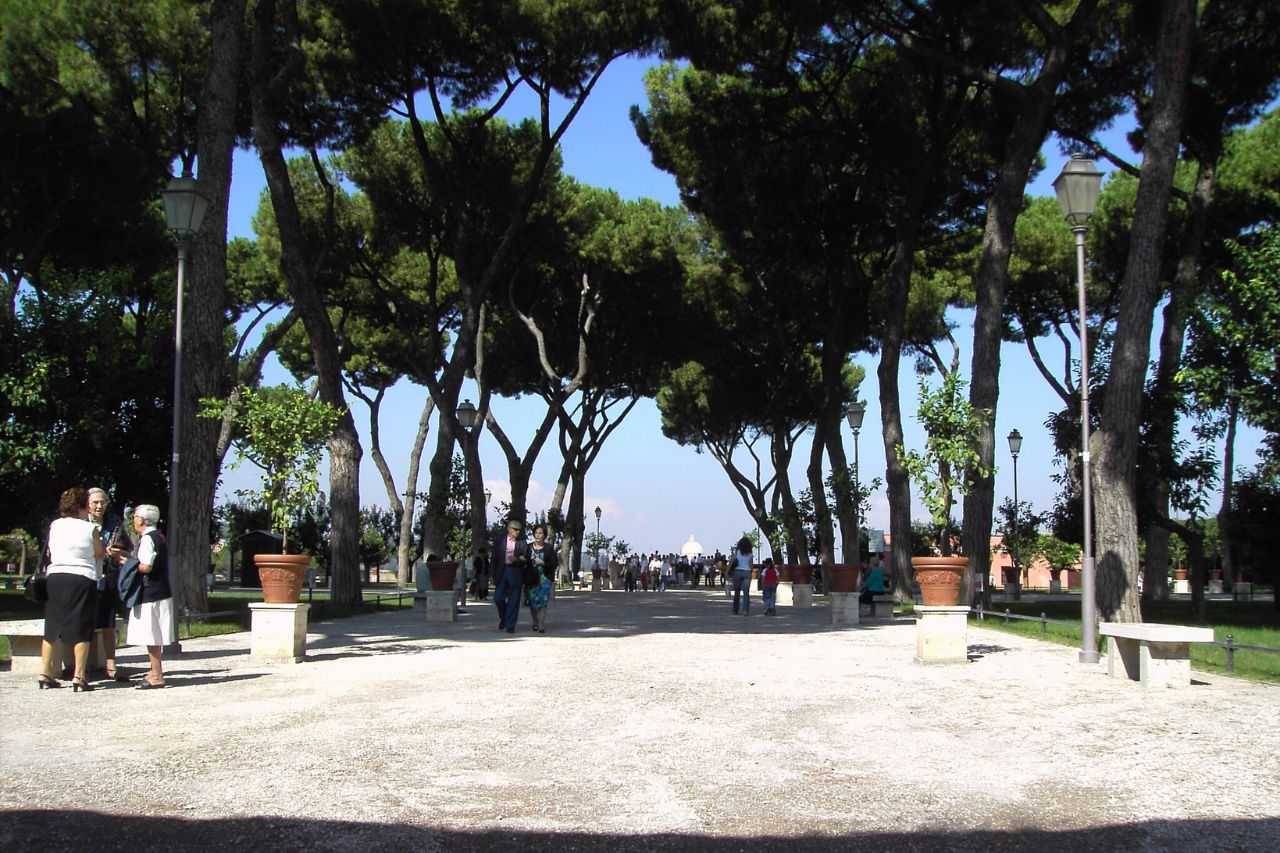
The Parco Savello, or Orange Gardens, is located next to the Aventine hill and was built in 1932 by R. de Vico. The site had to be used as a public park for the priests of the Dominican order who also took care of these gardens. At the entrance, you can smell a strong perfume of citrus coming from the orange trees, planted to honor St. Dominic and his passion for this plant. Moreover, from 1937 this area is enriched by the main door (once part of Villa Balestra). This enchanting garden offers a serene and picturesque retreat amidst the bustling city.
The sweet fragrance of the orange trees envelops you as you wander through the lush pathways, creating a sensory experience that is both calming and rejuvenating. The historical significance of the garden, coupled with its stunning views of Rome, makes it a hidden gem for both relaxation and contemplation.
Historical Figures
Do you know who contributed to make Rome this iconic? Read to find out.
20. Giulio Cesare
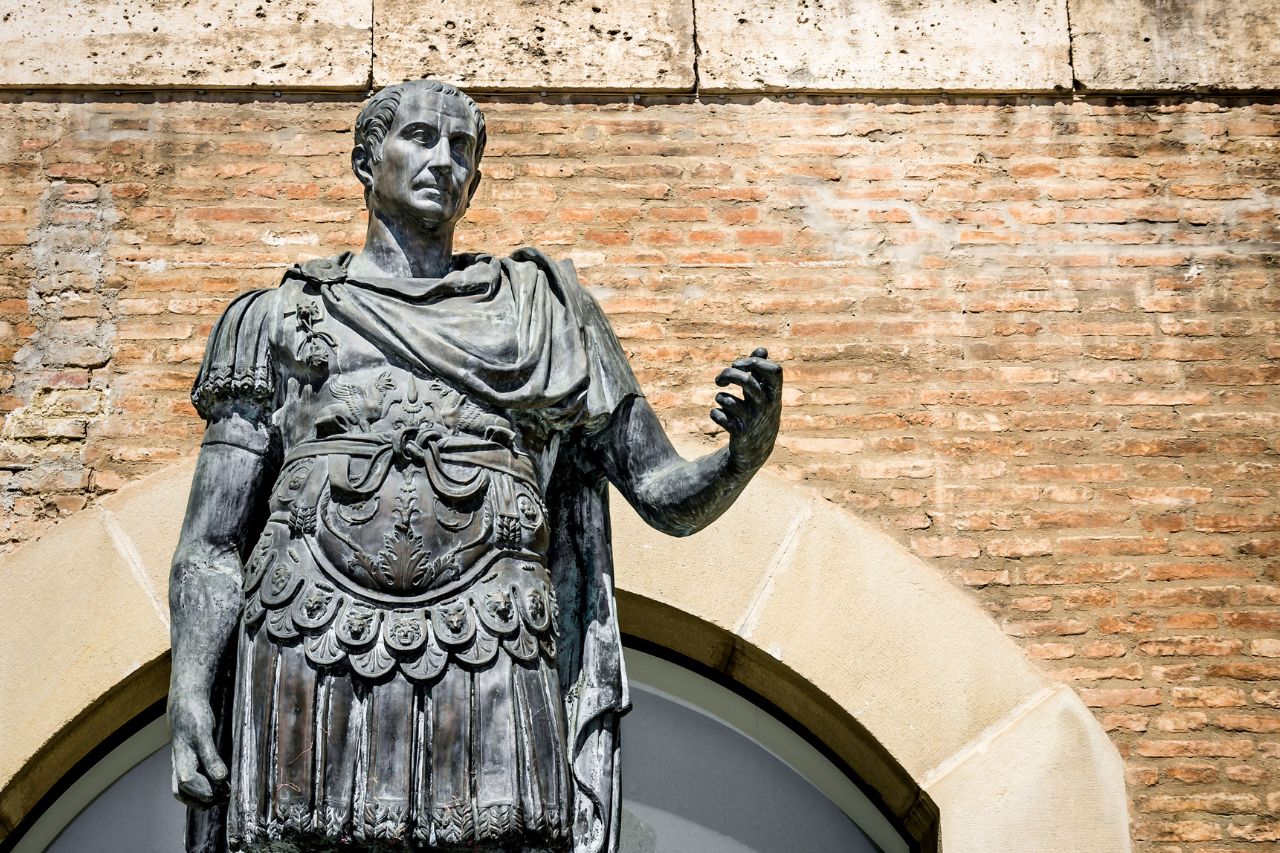
Julius Caesar was an important consul and dictator. After multiple successes in military campaigns, he undertook revolutionary social reforms. His rise caused many tensions with the Roman Senate. Indeed, in 44 BC, Caesar was assassinated during a plot by Brutus, his step-son. This moment was followed by political instability, which contributed to the decline of the Roman Republic. Caesar’s life and death are pivotal chapters in Roman history, symbolizing the complex interplay of power, ambition, and governance. His legacy extends far beyond his military conquests, deeply influencing the political and social fabric of Rome.
The aftermath of his assassination marked a significant turning point, leading to the end of the Roman Republic and the rise of the Roman Empire. His story, steeped in drama and intrigue, continues to fascinate historians and laypersons alike, underscoring the enduring impact of his leadership and the turbulent times he navigated.
21. Cleopatra
Has someone ever told you who is the historical woman for what is Rome famous for? Cleopatra (officially Cleopatra VII) was the last Queen of Ancient Egypt. Known for her beauty and intelligence, the ruler allied herself with Julius Caesar (his partner and father of his son) and Mark Antony. The secret love affair with the latter brought troubles in the political environment of Ancient Rome. However, her Kingdom ended with the Battle of Actium in 31 BC in which Augustus defeated the naval fleet of the woman and her lover. Cleopatra’s life is a tapestry of romance, power, and intrigue, painting a vivid picture of a woman who defied the norms of her time.
Her alliances and relationships with some of Rome’s most powerful men not only shaped her reign but also had profound implications on the course of Roman history. Her dramatic demise marked the end of an era and the beginning of Roman dominance over Egypt.
22. Traiano

Trajan was the Roman Emperor (from 98 to 117 AC) who let Rome reach its greatest territorial extent. After many political campaigns, he conquered Dacia (actual Romania) and expanded the borders of the Empire. The iconic Trajan Column of the Forum of Trajan are the two must-see spots which commemorate his successes. Trajan’s rule is often remembered as a period of military strength, architectural innovation, and administrative efficiency. His victories in Dacia not only brought immense wealth to Rome but also showcased his military prowess.
Trajan’s Column, with its intricate spiral bas relief, vividly narrates the story of the Dacian Wars, offering an immersive historical experience. The Forum, a marvel of ancient urban planning, reflects his dedication to the improvement of Roman society and infrastructure. Visiting these sites provides a deeper understanding of Trajan’s impact on Rome, highlighting his legacy as one of the greatest Roman Emperors whose reign set a benchmark for prosperity and expansion in the ancient world.
Vatican
Discover the most important parts of the fulcrum of Catholicism.
23. St. Peters’ Basilica
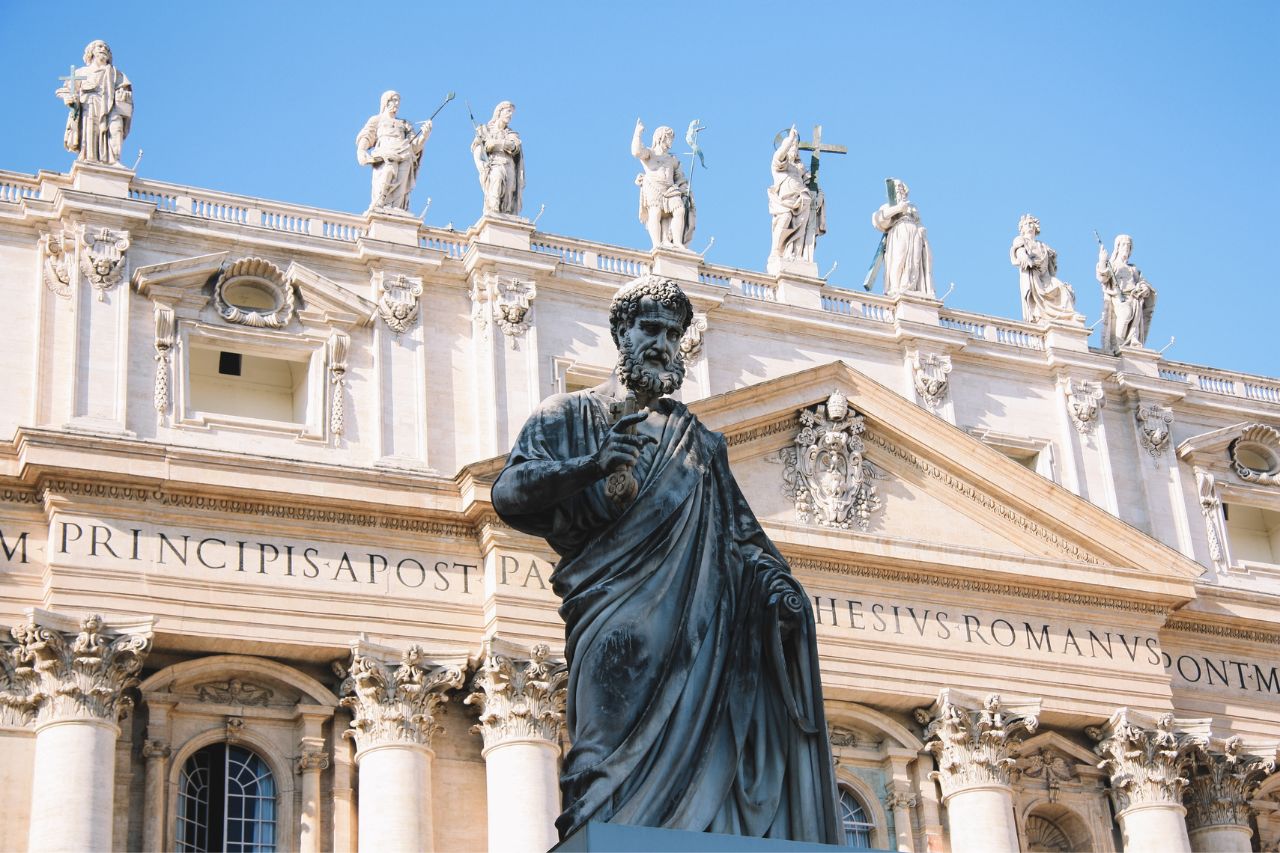
The Saint Peter’s Basilica has been the heart of Vatican city since 1626. Known as the center of Christianity, the complex is rich in Baroque detailed and hosts the “Pity” by Michelangelo with a dying body of Jesus after his Crucifixion and the Baldacchino (site where St. Peter is buried). This majestic basilica is not just a monument but a symbol of faith and artistry. Its grandeur and beauty captivate visitors from around the world. Inside, every corner and crevice tells a story of religious significance and artistic endeavor.
The Pietà, a masterpiece of Renaissance sculpture, encapsulates the sorrow and compassion of the Virgin Mary, while Bernini’s Baldacchino stands as an imposing masterpiece of Baroque art, marking the burial site of St. Peter. As you wander through this architectural wonder, you can feel the deep spiritual and historical presence that permeates the basilica, making it a place of pilgrimage and awe.
24. Vatican Museums

Did you know which is the museum for what is Rome famous for around the world? The Vatican Museums is a Mecca of culture rich in Roman and Hellenic art collections. Among must-see spots, you surely can’t miss the 4 Raphael Rooms, Michelangelo’s Sistine Chapel and the Pinacoteca, with more than 460 paintings made by greatest artists. This vast complex is a treasure trove of artistic masterpieces, each room and gallery unfolding a new chapter in the history of art. The Raphael Rooms showcase the genius of Raphael’s frescoes, enveloping visitors in scenes of breathtaking beauty and historical significance.
The Sistine Chapel, with its iconic ceiling and ‘The Last Judgment’, stands as a testament to Michelangelo’s unparalleled skill and vision. The Pinacoteca, with its rich collection of paintings, takes you on a journey through the evolution of art from the Middle Ages to the modern era.
25. St. Peter’s Square
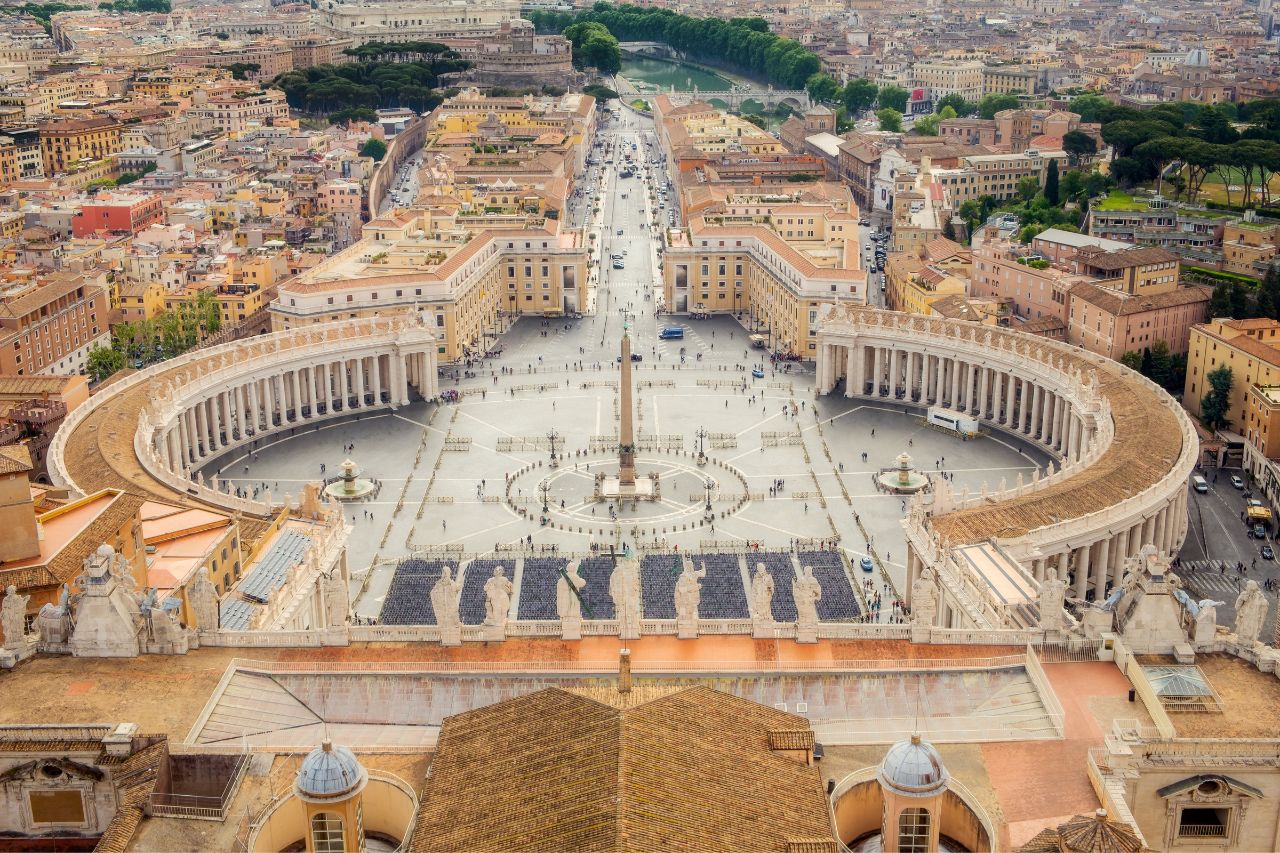
St. Peter’s Square was opened to the public in 1667 and projected by G. Bernini. The area daily hosts millions of visitors and Catholics, ready to hear Pope Francis’ speeches. Moreover, when there, it’s impossible not to be amazed by the 248 columns of marble which surround the place. This grandiose square, with its iconic colonnades embracing the crowds, symbolizes the open arms of the Church reaching out to believers and visitors alike. The stunning symmetry and architectural genius of Bernini create a sense of awe and spiritual magnificence.
The square, with its central obelisk and twin fountains, provides a perfect backdrop for the majestic Basilica. As you stand in this vast expanse, you are part of the rich tapestry of history, art, and religion that defines Vatican City. St. Peter’s Square is not just a physical space; it’s a spiritual journey, a meeting point of faith, culture, and history, making it a quintessential experience for anyone visiting Rome.
Food
Hungry? When in Rome, ask the restaurant owner to try these delights.
26. Carbonara
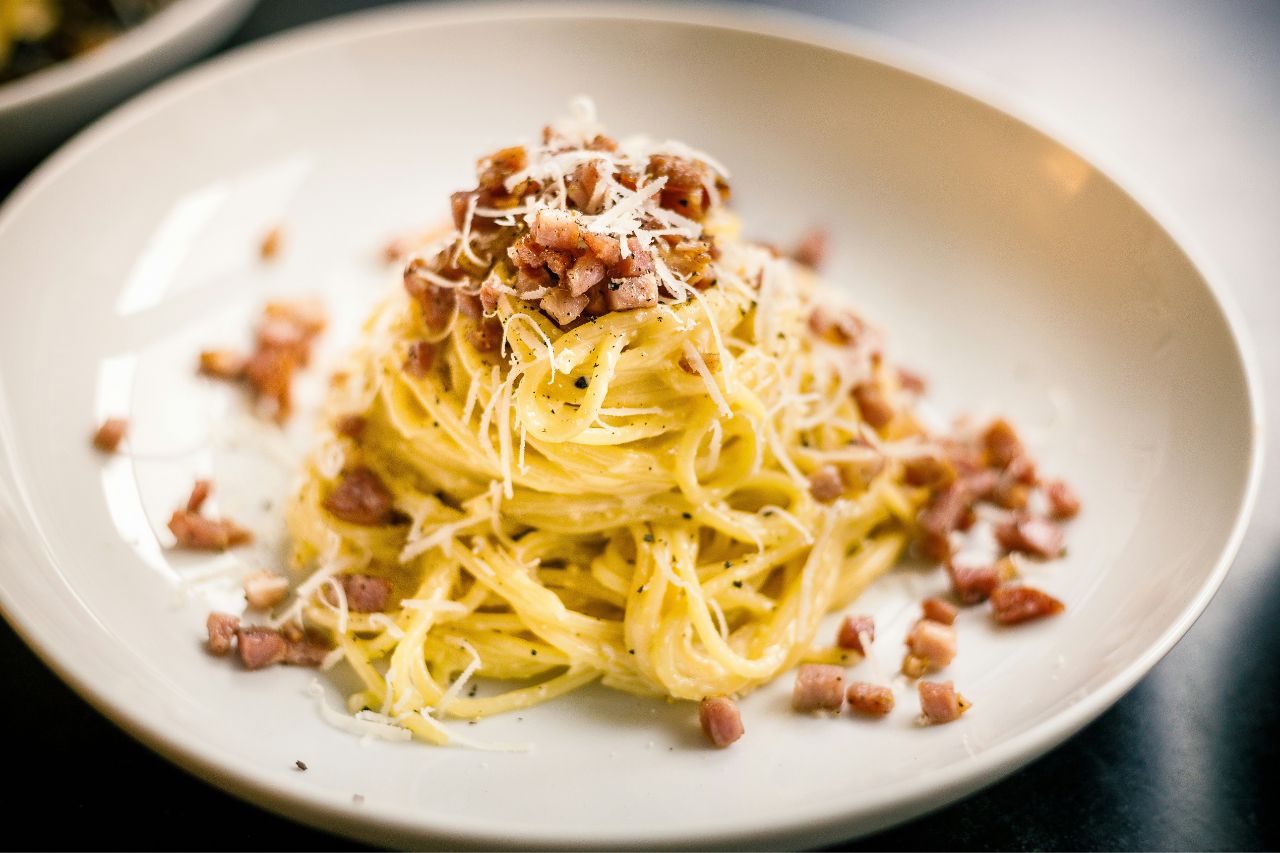
The iconic carbonara is generally prepared with spaghetti or rigatoni pasta and made with eggs, pecorino cheese, guanciale and black pepper. The latter’s creamy sauce is obtained by mixing the eggs and cheese with the residual heat of the freshly drained pasta. This classic Roman dish is a sublime blend of simple yet rich flavors, showcasing the art of Italian cuisine in creating sumptuous meals with a few high-quality ingredients.
The key to a perfect carbonara lies in the balance of its ingredients, each playing a crucial role in creating the signature velvety texture and savory taste. Carbonara is not just a dish; it’s a culinary experience that embodies the heart and soul of Roman gastronomy. Its enduring popularity among locals and tourists alike is a testament to its delicious simplicity and the pleasure that comes from a well-prepared, comforting meal.
27. Cacio e Pepe
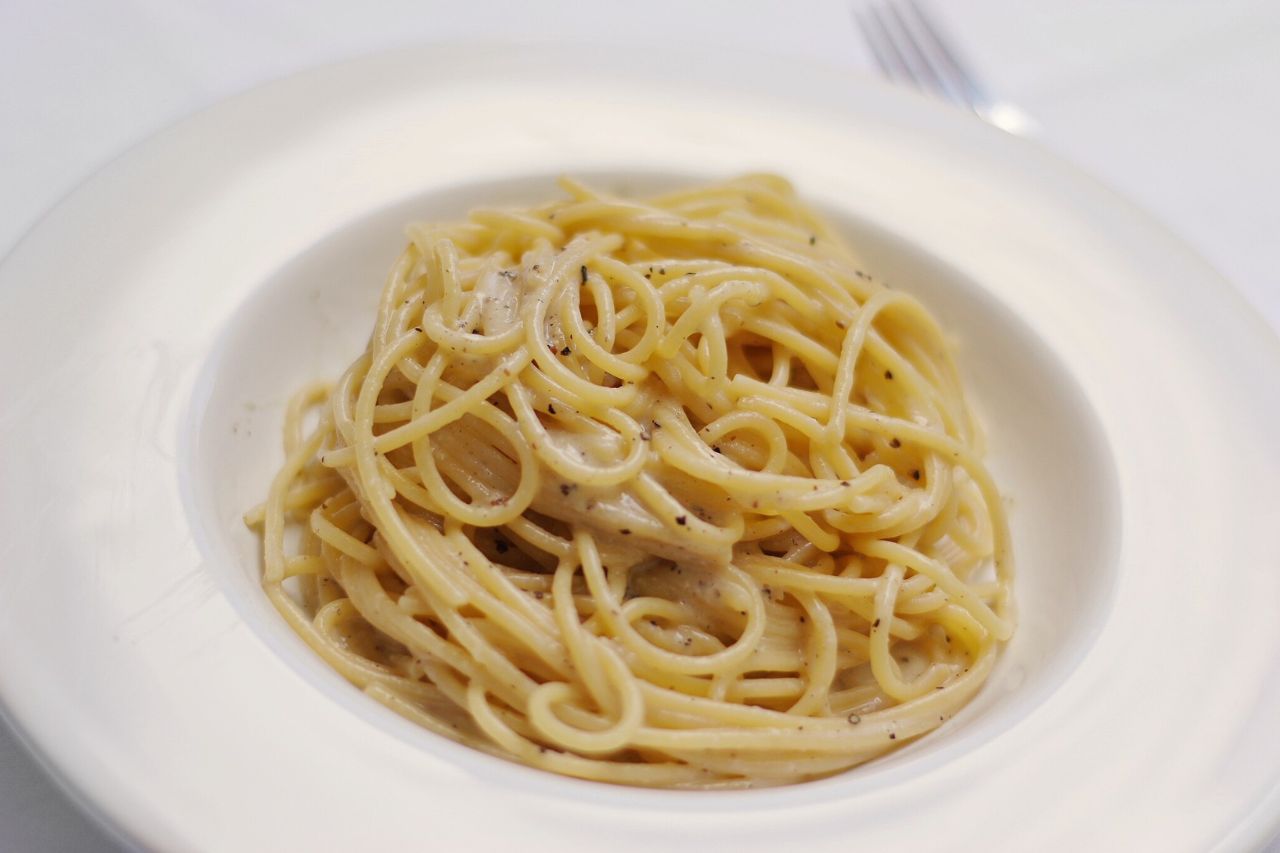
Known for being the symbol of the Roman kitchen, the cacio & pepe is commonly prepared with spaghetti or tonnarelli fresh pasta. The list of ingredients counts: pecorino cheese, black pepper and heating water, whose mix creates a one of a kind sauce. This quintessentially Roman dish is a marvel of culinary simplicity yet delivers an explosion of flavors. The magic of cacio e pepe lies in its preparation, where the starchy pasta water emulsifies with the cheese and pepper to create a creamy, yet cheese-rich sauce that perfectly coats each strand of pasta.
This dish is a testament to the Roman’s ability to create incredibly flavorful dishes with minimal ingredients. The sharpness of the pecorino and the warm bite of the black pepper combine to offer a comforting yet sophisticated eating experience.
28. Amatriciana
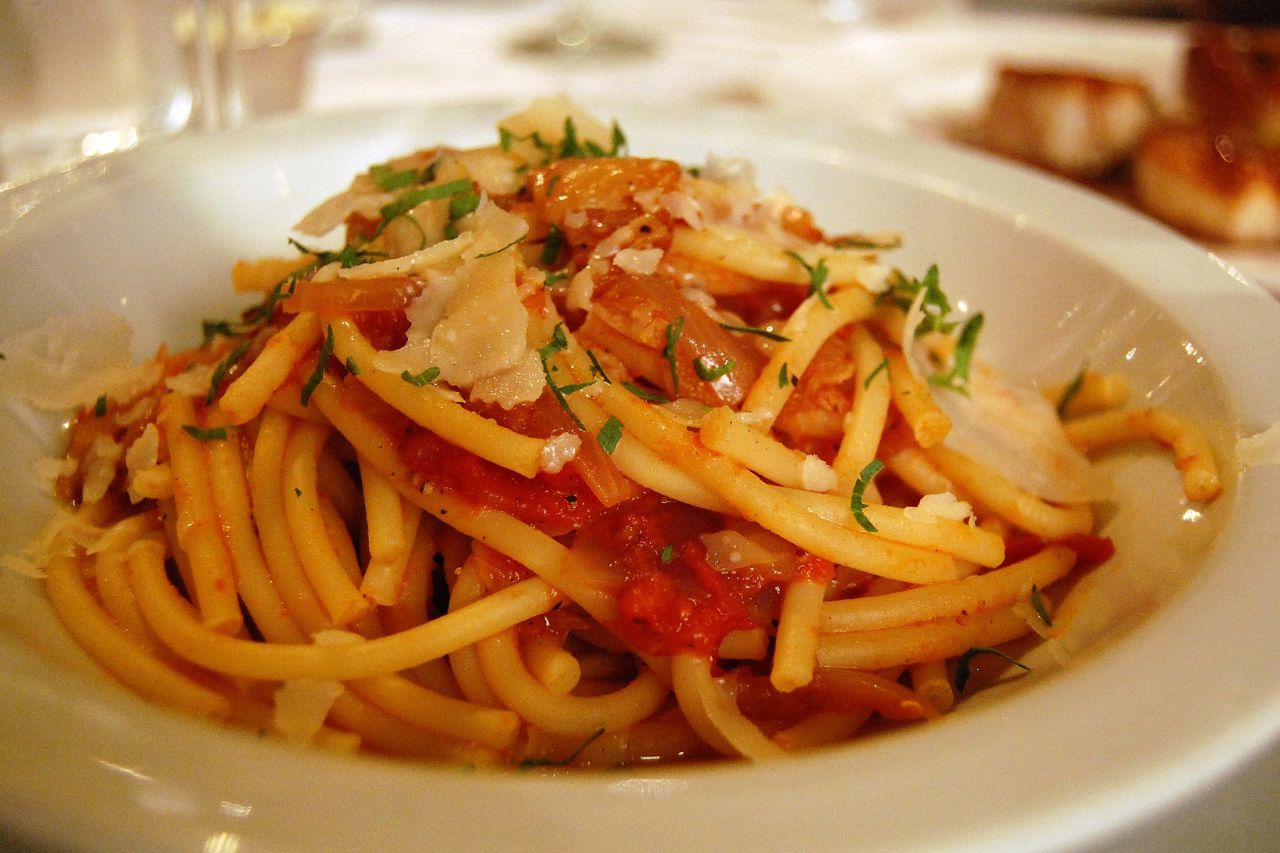
Do you know which is the plate for what is Rome famous for globally? Taking its name from the city of Amatrice (in Latium), the amatriciana is mainly made of guanciale, tomato sauce, black pepper and pecorino cheese. The tasty sauce is obtained by browning the bacon and adding tomato until the consistency gets thick. This classic dish is a staple of Roman cuisine, revered for its robust and heartwarming flavors. The key to its deliciousness lies in the quality of the guanciale, which imparts a rich, porky depth to the sauce, perfectly complemented by the tangy tomato and the sharp, salty pecorino.
The black pepper adds a subtle heat that rounds out the dish. Amatriciana is not just a recipe; it’s a culinary heritage, a flavorful journey through Roman gastronomic history. Each bite is a delightful blend of tradition and taste, making it a must-try for anyone seeking to experience the authentic flavors of Rome.
FAQs about What is Rome Famous For
Here’s our answers to the most frequent questions about what is Rome famous for.
What is Rome Unique For?
Rome, the capital of Italy, is unique for multiple reasons, from the fascinating history and the cultural heritage to the welcoming attitude of its people. This city always captivates visitors with the impressive Roman ruins, including iconic monuments like the Trevi Fountain or the Colosseum making the ‘città’ a mesmerizing destination. All of this accompanied by the beauty of the adjacent Vatican City (independent enclave within Rome) and seat of the catholic religion.
Why Was Rome So Popular?
Over the centuries, Rome gained its fame thanks to its role in shaping Western civilization. Indeed, the Eternal city was the political, economical and military epicenter of Europe. Moreover, this town (at a certain point of the history) started to covet visitors thanks to the building of its architectural marvels and to the literary and philosophical tributes received from the greatest writers ever.
Why is Rome so Important to us?
Nowadays, Rome is deeply important to us as it’s still a melting pot of traditions and a valid seat of governance and cultural development. On an intellectual level, Rome is the city from which Latin developed, the mother tongue of all major European languages without forgetting its role in shaping our understanding of history, language and political system, still influenced by the Roman Empire one.
Conclusion
In conclusion, Rome is a city where history, art, and culture converge, creating a rich and enduring legacy. The awe-inspiring landmarks, such as the Colosseum and St. Peter’s Basilica, each narrate the city’s pivotal role in shaping history. Masterpieces like Michelangelo’s Sistine Chapel and Bernini’s Apollo and Daphne epitomize the city’s artistic zenith. Rome’s culinary offerings, including the classic Carbonara and the hearty Amatriciana, echo its rich culinary traditions. Every corner of Rome offers a glimpse into the past, making it more than just a destination but a journey through the cradle of civilization. Here, every step is a foray into the heart of human achievement, in a city that continues to enchant with its timeless splendor.


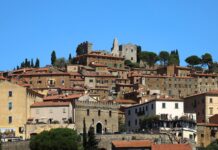
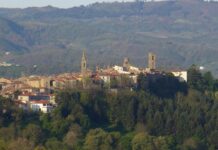
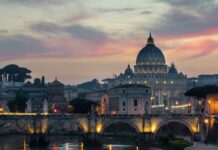






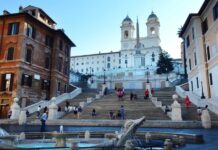


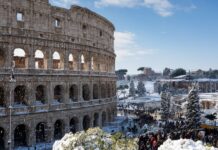
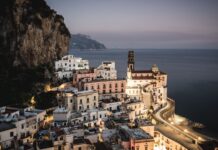
![what-is-rome-famous-for[1] what is rome famous for](https://italytravelsecrets.com/wp-content/uploads/2024/01/what-is-rome-famous-for1-1068x542.jpg)
